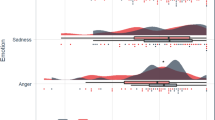Abstract
Affective information processing is analysed considering the emotion circuits within the brain substrates of emotionality. Based on Gärdenfors’ [8] conceptual spaces model we try to examine an emotion episode from its elicitation to the differentiation into affective processes. An affective-conceptual spaces model is developed taking in consideration Panksepp’s [20] nested BrainMind hierarchies.
Access this chapter
Tax calculation will be finalised at checkout
Purchases are for personal use only
Preview
Unable to display preview. Download preview PDF.
Similar content being viewed by others
References
Arnold, M.B.: Emotion and personality. Columbia University Press, New York (1960)
De Houwer, J., Hermans, D.: Do feelings have a mind on their own? In: De Houwer, J., Hermans, D. (eds.) Cognition & Emotion: Reviews of Current Research and Theories. Psychology Press, Hove (2010)
Cromwell, H.C., Panksepp, J.: Rethinking the cognitive revolution from a neural perspective: How overuse/misue of term ‘cognition’ and the neglect of affective controls in behavioral neuroscience could be delaying process in understanding the BraiMind. Neuroscience and Biobehavioral Reviews (2011)
Damasio, A.: The self comes to mind. Pantheon, New York (2010)
Fockenberg, D., Koole, S.L., Semin, G.R.: Backward affective priming: Even when the prime is late, people still evaluate. Journal of Experimental Social Psychology 42, 799–806 (2006)
Freyd, J.: Shareability: the social psychology of epistemology. Cognitive Science 7 (1983)
Frijda, N.H.: The emotions. Cambridge University Press, New York (1986)
Gärdenfors, P.: Conceptual Spaces: The Geometry of Thought. MIT, Cambridge (2000)
Glass, A., Holyoak, K., Santa, J.: Information processing and social cognition. Cognition (1979)
Klauer, K.C., Teige-Mocigemba, S.: Controllability and resource dependence in automatic evaluation. Journal of Experimental Social Psychology 43, 648–655 (2007)
Lazarus, R.S.: Psychological stress and the coping process. McGraw-Hill, New York (1966)
Lazarus, R.S.: Emotion and adaptation. Oxford University Press, New York (1991)
Marion, R.: The Boy Who Felt No Pain. Addison-Wesley, Mass (1990)
Marr, D.: Vision: A Computational Approach. Freeman & Co., San Francisco (1982)
Moors, A.: Theories if emotion causation: A review. In: De Houwer, J., Hermans, D. (eds.) Cognition & Emotion: Reviews of Current Research and Theories. Psychology Press, Hove (2010)
Oatley, K., Johnson-Laird, P.N.: Towards a cognitive theory of emotions. Cognition and Emotion 1, 29–50 (1987)
Ortony, A., Clore, G.L., Collins, A.: The cognitive structure of emotions. Cambridge University Press, Cambridge (1988)
Panksepp, J.: Affective Neuroscience: The Foundations of Human and Animal Emotions. Oxford University Press, New York (1998)
Panksepp, J. (ed.): Textbook of biological psychiatry, pp. 75–110. Wiley, Hoboken (2004)
Panksepp, J.: What is an emotional feeling? Lessons about affective origins from cross-species neuroscience. Motivation and Emotion, 1–12 (2011a)
Panksepp, J.: Cross-species affective neuroscience decoding of the primal affective experiences of humans and related animals. PLoS One (2011b)
Pfaff, D.: Brain Arousal and Information Theory: Neural and Genetic Mechanisms. Howard University Press, Cambridge (2006)
Quine, W.V.O.: Natural kinds. In: Ontological Relativity and Other Essays, pp. 114–138. Columbia University Press, New York (1969)
Roseman, I.J., Antoniou, A.A., José, P.E.: Appraisal determinants of emotions: Constructing a more accurate and comprehensive theory. Cognition and Emotion 10(3), 241–277 (1996)
Scherer, K.R.: On the nature and function of emotions: A component process approach. In: Scherer, K.R., Ekman, P. (eds.) Approaches to Emotion, pp. 293–317. Lawrence Erlbaum Associates, Inc., Hillsdale (1984)
Schneidman, E., Still, S., Berry II, M.J., Bialek, W.: Network information and connected correlations. Phys. Rev. Lett. 91(23), 87–101 (2003)
Shannon, C.E.: A mathematical theory of communication. AT&T Labs Tech., J. 24, 49–65 (1948)
Sharpee, T., Rust, N.C., Bialek, W.: Analyzing neural responses to natural signals: maximally informative dimensions. Neural Comput. 16(2), 223–250 (2004)
Smith, C.A., Ellsworth, P.C.: Patterns of cognitive appraisal in emotion. Journal of Personality and Social Psychology 48, 813–838 (1985)
Sugu, D., Chatterjee, A.: Flashback: Reshuffling emotions. IJHI 3(1), 109–135 (2010)
Sugu, D., Chatterjee, A.: Gärdenfors’ Conceptual Spaces and Affective Representations. IJHI 4(1), 11–17 (2011)
Tooby, J., Cosmides, L.: Toward mapping the evolved functional organization of mind and brain. In: Gazzaniga, M.S. (ed.) The New Cognitive Neuroscience, pp. 1167–1178. MIT Press, Cambridge (2000)
Watt, D.F.: Panksepp’s common sense view of affective neuroscience is not the commonsense view in large areas of neuroscience. Consciousness and Cognition 14, 81–88 (2005)
Watt, D.F., Pincus, D.I.: Neural substrates of consciousness: Implications for clinical psychiatry. In: Panksepp, J. (ed.) Textbook of Biological Psychiatry, pp. 75–110. Wiley, Hoboken (2004)
Zadeh, L.A.: The role of fuzzy logic in the management of uncertainty in Expert Systems. Fuzzy Sets and Systems 11, 199–227 (1983)
Author information
Authors and Affiliations
Editor information
Editors and Affiliations
Rights and permissions
Copyright information
© 2012 Springer-Verlag Berlin Heidelberg
About this paper
Cite this paper
Sugu, D., Chatterjee, A. (2012). Affective Information Processing and Representations. In: Kundu, M.K., Mitra, S., Mazumdar, D., Pal, S.K. (eds) Perception and Machine Intelligence. PerMIn 2012. Lecture Notes in Computer Science, vol 7143. Springer, Berlin, Heidelberg. https://doi.org/10.1007/978-3-642-27387-2_6
Download citation
DOI: https://doi.org/10.1007/978-3-642-27387-2_6
Publisher Name: Springer, Berlin, Heidelberg
Print ISBN: 978-3-642-27386-5
Online ISBN: 978-3-642-27387-2
eBook Packages: Computer ScienceComputer Science (R0)




